See also:
Everyone knows it is best to use USB Chargers that originally came with your device for charging. The problem is getting a suitable replacement when the original is bad or missing.
Using fake chargers or USB cables, you will most likely experience slow charge or slower data transfer rate while transferring files to a PC. In some cases, a PC may not detect your phone if the USB cable is a knockoff
How do you identify original Micro-USB Cable for replacement?
Here are two simple ways to identify Original USB cables, both by physical observation. |
| Original USB Cable |
 |
| Knockoff USB Cable |
See also:
Charging Smartphones with USB Could Lead to Data Thefts and Malware Infections, Experts warn.
1. Check the type of conductor.
Before buying a USB Cable, take a good look at the bus/contact. You can see the contact through two holes as shown in the picture below. Look out for the color of the conductor inside. If it is gold, that means it's having a copper conductor which is fine. If its aluminum, it's probably fake. This is because copper has very high conductivity compared to aluminum. It has higher current density, hence for the given current rating lesser cross-sectional area of the conductor is required. Aluminium is less expensive and mostly used by small accessories makers to cut down cost.
 |
| Original USB with Copper conductors, Aluminium Conductors perform poorer |
2. Check the PINs of the micro-USB Connector
Another way is to check the number of pins in the micro-USB connector. Observe the side that connects to your smartphone's micro-USB port, check the number of Pins you find inside. Using an original Samsung micro-USB cable as a case study. You will see that the fourth pin is missing.While that of the fake USB cable is complete.
N/B: The first method can be used for other USB cables, it isn't limited to micro-USBs alone.
Hope this was helpful? If you have other ways to identify original USB cables, feel free to drop it in the comments.











Post a Comment Blogger Facebook